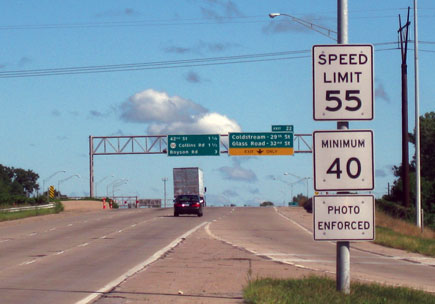In the United States, speeding is by far the leading factor in fatal crashes—equivalent to the use of drugs, alcohol, medication, and distracted driving combined. But although automated speed enforcement (ASE) is a promising countermeasure shown to reduce speeding and crashes, the idea remains contentious.
“Despite the demonstrated safety benefits of ASE, we’ve seen its deployment continue to be a highly controversial issue,” says Frank Douma, director of the State and Local Policy Program at the Humphrey School of Public Affairs. “Several states have enacted restrictions or even banned the use of ASE systems, and ASE has been rejected in a number of public referendums.”
To chart a possible path to ASE deployment, U of M researchers have completed a new study focusing on ASE in Minnesota. The research team included Douma, graduate research assistant Colleen Peterson with the Humphrey School, and Nichole Morris, principal researcher with the HumanFIRST Lab. The project was funded by the Roadway Safety Institute.
in school zones could help build support for
its broader use. Photo: Shutterstock
“We believe our state is a good candidate for ASE, because public support for ASE is strong and it has been listed as a potential strategy in previous state strategic highway safety plans,” Douma says.
The study was conducted in three parts. First, investigators completed interviews with influential Minnesota stakeholders to better understand the arguments for and against ASE. The research team conducted 18 interviews within 4 stakeholder groups: public health, law enforcement, judicial, and government. Care was taken to create a varied pool of respondents within each category, across rural-suburban-urban divides, and from both political parties.
“Most of the interviewees suggested some level of support for ASE, especially if it is backed by strong data showing positive benefits and is implemented in a way that prevents abuse,” says Douma. “We were also able to more clearly define the major issues surrounding ASE deployment by grouping them into 10 categories and figuring out which categories were deal breakers and which were up for discussion. For example, due process and improved safety are must-haves, while implementation options and financial structures are more flexible.”
Next, they compared the rates of motor vehicle fatalities in states using ASE to Minnesota’s rates. Finally, they evaluated public concerns about ASE to better understand the causes for continued conflict regarding ASE deployment among the general Minnesota population and to potentially identify avenues for reconciling this conflict.
“Negative perceptions of ASE are often related to misunderstandings about its constitutionality and the public safety threat posed by speeding,” Douma says. “Concerns about big government and use of revenues generated by ASE are also fairly common.”
Researchers say that framing the use of automated speed enforcement as a clear and effective safety tool to address a profound public health problem will increase public support for its deployment. In addition, because large majorities in several surveys approve of ASE in high-risk areas like school and work zones—where drivers often speed excessively—they say limited ASE deployment in those areas may be a beneficial foothold to build support for its use.
“Ultimately, connecting speed and its effects on road safety in the minds of the public will help create a conducive environment for the deployment of more effective enforcement tools, including automated speed enforcement,” Douma says.




